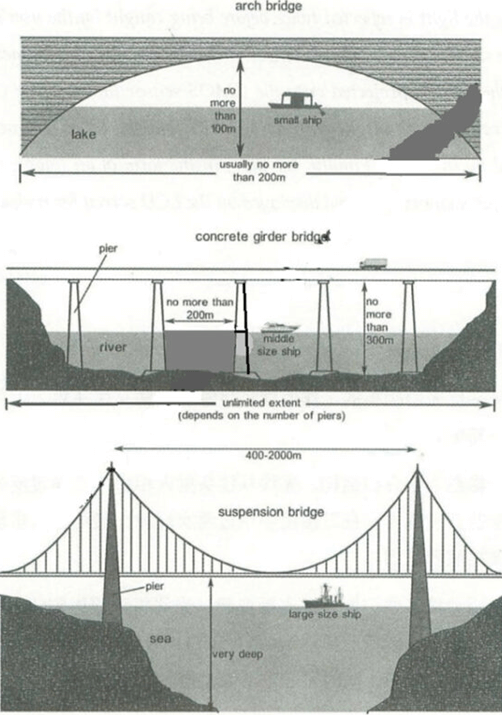5+ The pictures below show three different kinds of bridges. Summarise the information by selecting
The pictures below show three different kinds of bridges. Summarise the information by selecting and reporting the main features, and make comparisons where relevant. Write at least 150 words hay nhất giúp bạn có thêm tài liệu tham khảo để viết bài luận bằng Tiếng Anh hay hơn.
- The pictures below show three different kinds of bridges. Summarise the information by selecting (mẫu 1)
- The pictures below show three different kinds of bridges. Summarise the information by selecting (mẫu 2)
- The pictures below show three different kinds of bridges. Summarise the information by selecting (mẫu 3)
- The pictures below show three different kinds of bridges. Summarise the information by selecting (mẫu 4)
- The pictures below show three different kinds of bridges. Summarise the information by selecting (mẫu 5)
- The pictures below show three different kinds of bridges. Summarise the information by selecting (mẫu 6)
- The pictures below show three different kinds of bridges. Summarise the information by selecting (mẫu 7)
- The pictures below show three different kinds of bridges. Summarise the information by selecting (mẫu 8)
- The pictures below show three different kinds of bridges. Summarise the information by selecting (mẫu 9)
- The pictures below show three different kinds of bridges. Summarise the information by selecting (mẫu 10)
- The pictures below show three different kinds of bridges. Summarise the information by selecting (mẫu 11)
5+ The pictures below show three different kinds of bridges. Summarise the information by selecting
Đề bài: The pictures below show three different kinds of bridges. Summarise the information by selecting and reporting the main features, and make comparisons where relevant. Write at least 150 words.

The pictures below show three different kinds of bridges. Summarise the information by selecting - mẫu 1
The pictures compare the designs of the arch bridge, the concrete girder bridge and the suspension bridge. Overall, each model has a distinctive structure and is erected over a different body of water.
The arch bridge is supported by an abutment anchored at each end. This model spans over a lake and has a limited length of 200m and bridge clearance of 50m, allowing only small ships to travel through.
In comparison, the concrete girder bridge is constructed across a number of l-shape piers which are positioned under 200m apart, allowing the span to reach any desirable length. This structure, hence, is usually engineered to cross a larger body of water such as a river. With bridge clearance of approximately 150m, the concrete girder bridge can cater for medium-sized ships.
Standing out as the most massive structure among the three, the suspension bridge is able to span over a vast distance such as the deep sea. The erection of such a megastructure requires support from a combination of main towers and suspension cables. These towers can be spaced 400-2000m apart depending on the topography. The main cables are suspended between two adjacent towers and are connected to the bridge by vertical suspenders. Having the greatest bridge clearance, the suspension bridge can accommodate even large vessels.
The pictures below show three different kinds of bridges. Summarise the information by selecting - mẫu 2
The pictures compare the design of three types of bridges which are the arch, concrete girder, and suspension bridge. The trend suggests that each model is designed based on the nature of a particular location, with the arch bridge clearly having the simplest structure of all.
In terms of length, while the arch bridge can only span a gap of less than 200m, the design of the concrete girder bridge allows for unlimited extension, depending on how many piers it is constructed with. Meanwhile, it seems that the suspension bridge has no limits with regard to how far it can stretch a gap. Additionally, this bridge model can be built over the sea where large ships usually set sail. The arch and concrete girder bridges are only suitable for narrower water bodies such as lakes and rivers.
Regarding height, arch and concrete girder bridges can only be respectively raised up to 100m and 300m above water level, whereas the suspension bridge structure can be built on deep-sea levels. Finally, the concrete girder model has more piers than the other two, with each one being less than 200m apart.
Overall, it seems quite clear that each one of these models can serve a different purpose.
The pictures below show three different kinds of bridges. Summarise the information by selecting - mẫu 3
The following diagrams provide an insightful portrayal of three distinct types of bridges, each designed for specific purposes and environments.
In broad strokes, the arch bridge serves as a connection over a lake, boasting the shortest length and height. Contrarily, the concrete girder bridge caters to extensive spans, reliant on strategically placed piers. Lastly, the suspension bridge finds its utility in connecting towns, cities, or islands over vast bodies of water, especially oceans.
Let’s delve into the details of the arch bridge, designed for lake crossings. With a maximum length of 200m and a height reaching up to 100m from the lake bed, this bridge accommodates small vessels due to its semi-circular pier formation. The roadway runs parallel to the water’s surface, emphasizing its purpose as a compact lake connector.
Shifting our focus to the concrete girder bridge, this design proves ideal for spanning rivers. Piers, spaced at intervals less than 200m, provide crucial support for both vehicular traffic and the bridge’s own weight. Remarkably, the extent of this bridge is virtually limitless, with the tallest pillars reaching a height just under 300m, allowing passage for medium-sized ships.
The pictures below show three different kinds of bridges. Summarise the information by selecting - mẫu 4
The diagram details 3 different constructions for bridges. Looking from an overall perspective, it is readily apparent that concrete girder bridges are potentially the longest and tallest, while suspension bridges allow for the largest ships to pass underneath. Arch bridges are not as tall or long and admit only the smallest ships.
Looking first of all at arch bridges, the permissible height is no more than 100 meters, and the length is typically under 200m. These bridges are built over lakes, have a conical shape, and cover the smallest ships.
In contrast, concrete girder bridges can be an indeterminate length, though the maximum height is 300m. Concrete bridges are built over rivers and require a series of piers spaced under 200m apart to provide support, only allowing for the passage of medium-sized ships.
The modern suspension bridge can be between 400 and 2000m long and it is possible to build it over very deep seas as long as there is shallow land for pier structures to link at either end. The distance between piers enables the largest ships to traverse below safely.
The pictures below show three different kinds of bridges. Summarise the information by selecting - mẫu 5
The provided images compare 3 types of bridges.
First of all, the arch bridge, as the name suggests, has a curved shape. The total length of an arch bridge usually cannot exceed 200 meters, and the height is 100 meters at maximum. It is mostly constructed on lakes, so only small size boats can travel below.
Next, the concrete girder bridge consists of a straight road placed on many piers that are constructed on the riverbed to support the bridge. It can be extended without limit based on the number of piers which can be up to 300 meters high and 200 meters apart. Therefore, ships at medium size can travel under the bridge.
Lastly, the suspension bridge can be built across a sea channel. It can be between 400 and 2000 meters long, and the depth underneath is unlimited. It is supported by 2 towering piers and a system of suspension cables. This kind of bridge allows the navigation of massive ships.
Generally, the 3 types of bridges are completely different in terms of length, depth, location, and waterway transport underneath them.
The pictures below show three different kinds of bridges. Summarise the information by selecting - mẫu 6
The pictures illustrate three kinds of bridge that are used for different bodies of water, with a full technical display of the structural elements and their dimensions. Overall, the three bridges are designed according to the water body where they are situated, and thus differ greatly in terms of size and structures.
Lakes with a limited depth are where an arch bridge is constructed. The arch bridge typically stretches no more than 200 meters in length, with the center of its arch at a maximum height of 100 meters above the lake bed, which should allow small ships to maneuver underneath. In the case of deeper waters like a river, a concrete girder bridge is more fitting. It consists of an upper deck supported by an unlimited row of piers below, each of which is spaced at intervals of 200 meters from one another. The deck provides surface for travelling vehicles on the bridge, as well as being high enough (300 meters maximum) from the river bed for middle-size ships to sail through.
The suspension bridge lends itself more to vast seas of immense depth. Regarding its structure, two piers of enormous scale are placed from 400 meters to 2000 meters apart, which are further supported by cable suspenders. The deck held by these piers are placed high enough above the water to leave room for passing large ships.
The pictures below show three different kinds of bridges. Summarise the information by selecting - mẫu 7
The pictures compare the distinctive architectural and structural designs of three variations of bridge. Clearly, the number of piers as well as the allowed mode of maritime transportation of each bridge type varies, depending upon the topographical features of the sites.
To start with, the arch bridge, shaped as an upward curved arch, is a solid concrete block with no piers across the lake, whereas the concrete girder bridge, which vaults over the river, has a changeable number of pillars being proportional to the desirable length. Meanwhile, the suspension bridge is constructed with only two big and sturdy piers rooted into underwater cliffs near the seaport.
Concerning the technical requirements, these bridge designs hold striking differences. First, the arch bridge, with a limited length of 200 meters, has its abutments anchored to either side of a lake, whilst the concrete girder bridge has its columns positioned at a maximum distance of 200 meters from each other, making the suspension bridge the one with the longest span of up to 2000 meters. In addition, the overhead clearance makes them strictly exclusive to certain types of transport. Specifically, this figure for the arch bridge and the concrete girder bridge is 100 meters and 300 meters, respectively, so that small-sized and middle-sized ships can safely sail under them. Noticeably, the water level at the place where a suspension bridge is erected, usually very deep, helps to accommodate the operation of large-sized ships.
The pictures below show three different kinds of bridges. Summarise the information by selecting - mẫu 8
The pictures illustrate the structural designs of three different types of bridges. Overall, concrete girder bridges are potentially the longest, whereas suspension bridges are the highest. Additionally, each bridge is constructed depending on different topographical backgrounds and is suitable for different sizes of water vehicles.
Arch bridges, often built over a lake, are the smallest type of bridge. This can only serve the smallest boats. The maximum length of this type of bridge is 200 metres, which is the shortest and the maximum height is 100 metres, which is the lowest. Moreover, these bridges have no piers but only an arch in the middle.
Concrete girder bridges, connecting two riverbanks, can be extended unlimitedly based on the number of piers. The distance between each pier is up to 200 metres and the allowed height is under 300 metres. Regarding the vehicle passibility, only mediumsized ships can sail underneath these bridges.
Finally, suspension bridges can be constructed on the deep seabed. Two piers are located on each side of the bridges, with distances ranging from 400 to 2000 metres. They are constructed on two areas of land and anchored to the bridge by a series of suspender cables. The largest boats can have a journey through this type due to their architectural design.
The pictures below show three different kinds of bridges. Summarise the information by selecting - mẫu 9
The diagrams illustrate the design of three types of bridge.
Overall, the arch bridge is built to connect two sides of a lake, so it is the shortest in terms of both length and height. While the concrete girder bridge can cater for the longest spans (as long as there are enough piers), the suspension bridge is suitable for connecting towns, cities or islands over the ocean.
Regarding the arch bridge, its maximum length is 200m, and it can be up to 100m tall (from the bed of the lake), which only allows small ships to go through. This kind of bridge has two piers forming a semi-circular shape, with the roadway running parallel with the surface of the water.
Turning next to the concrete girder bridge, this design is suitable for bridging two banks of a certain river. Since there are piers – whose distance from one pair to the next must be under 200m – to support the pressure of vehicles and the weight of the bridge itself, its extent is unlimited. The tallest pillars are under 300m, so the girder bridge caters for medium-sized ships.
Finally, the distance between the two towers of the suspension bridge is from 400 to 2000m. It is of note that these piers are used to hang main cables with multiple suspender cables attached to the deck of the bridge to carry the weight of vehicles and the bridge. In addition, this structure is built in the sea and is tall enough to allow large vessels to pass through.
The pictures below show three different kinds of bridges. Summarise the information by selecting - mẫu 10
The given diagrams ilustrate the designs of three different types of bridges.
Overall, it is evident that while the arch bridge can only allow the smallest-sized ships to pass through, the suspension one is capable of catering for the largest ships. In addition, with its unlimited length, the concrete girder one can be the longest of all the given sorts of bridge.
With regard to the arch bridge, its maximum height is 100 meters, and its span normally does not exceed 200 meters. This kind of bridge is constructed across a lake, has the shape of a curved arch and can allow for the passage of small ships.
It is apparent that the length of the concrete girder bridge is unrestricted since this is dependent on the quantity of piers used to support the deck. The distance between each pair of piers is under 200 meters. The bridge is built to link two banks of a river and is up to 200 meters tall from the river bed so it can cater for medium-sized ships.
Finally, the suspension bridge is typically erected over a very deep sea and has two large piers attached to shallow land at each end. Its span can range from 400 to 2000 meters and the bridge is built tall enough to enable large vessels to travel through safely.
The pictures below show three different kinds of bridges. Summarise the information by selecting - mẫu 11
Overall, the design of the bridges differs in terms of their height and the use of piers. Each type is most suitable for specific locations, such as lakes, rivers and seas.
The arch bridge is constructed to cross small waterways such as lakes, and it has a maximum span of 200 meters. Its height of no more than 100 meters only permits small ships to sail under it. In contrast, the concrete girder bridge is built using piers, which cannot be more than 200 meters apart. However, there is no limit to the number of piers that can be used to cross larger bodies of water, such as wide rivers. Medium-sized ships can pass under this type of bridge, which may be 300 meters in height.
Finally, at sea, suspension bridges enable large ships to sail under them, because of the deep water which they span. The piers can be spaced between 400 and 2000 meters apart- depending on the topography – up to 10 times the distance between piers of the concrete girder bridge or the arches of the arch bridge.
Xem thêm các bài luận Tiếng Anh hay khác:
Đã có app VietJack trên điện thoại, giải bài tập SGK, SBT Soạn văn, Văn mẫu, Thi online, Bài giảng....miễn phí. Tải ngay ứng dụng trên Android và iOS.
Theo dõi chúng tôi miễn phí trên mạng xã hội facebook và youtube:Nếu thấy hay, hãy động viên và chia sẻ nhé! Các bình luận không phù hợp với nội quy bình luận trang web sẽ bị cấm bình luận vĩnh viễn.
- Đề thi lớp 1 (các môn học)
- Đề thi lớp 2 (các môn học)
- Đề thi lớp 3 (các môn học)
- Đề thi lớp 4 (các môn học)
- Đề thi lớp 5 (các môn học)
- Đề thi lớp 6 (các môn học)
- Đề thi lớp 7 (các môn học)
- Đề thi lớp 8 (các môn học)
- Đề thi lớp 9 (các môn học)
- Đề thi lớp 10 (các môn học)
- Đề thi lớp 11 (các môn học)
- Đề thi lớp 12 (các môn học)
- Giáo án lớp 1 (các môn học)
- Giáo án lớp 2 (các môn học)
- Giáo án lớp 3 (các môn học)
- Giáo án lớp 4 (các môn học)
- Giáo án lớp 5 (các môn học)
- Giáo án lớp 6 (các môn học)
- Giáo án lớp 7 (các môn học)
- Giáo án lớp 8 (các môn học)
- Giáo án lớp 9 (các môn học)
- Giáo án lớp 10 (các môn học)
- Giáo án lớp 11 (các môn học)
- Giáo án lớp 12 (các môn học)





 Giải bài tập SGK & SBT
Giải bài tập SGK & SBT
 Tài liệu giáo viên
Tài liệu giáo viên
 Sách
Sách
 Khóa học
Khóa học
 Thi online
Thi online
 Hỏi đáp
Hỏi đáp

